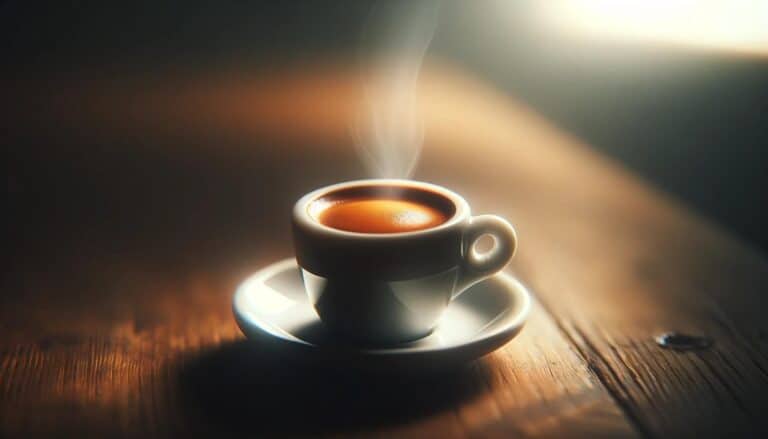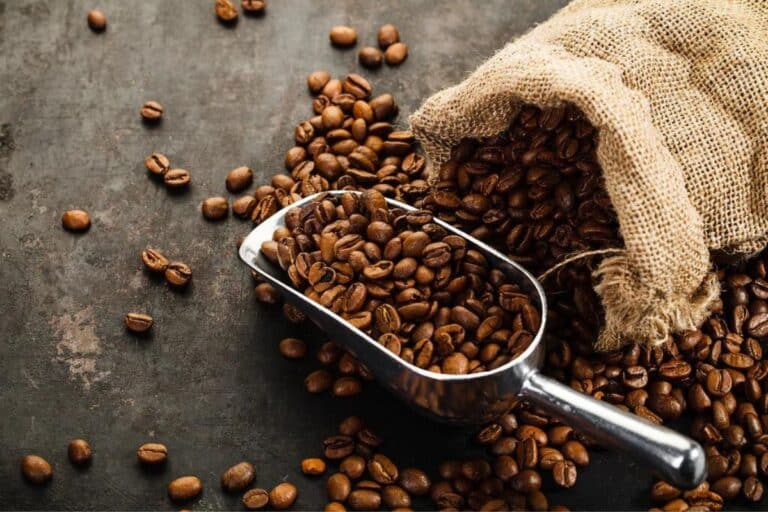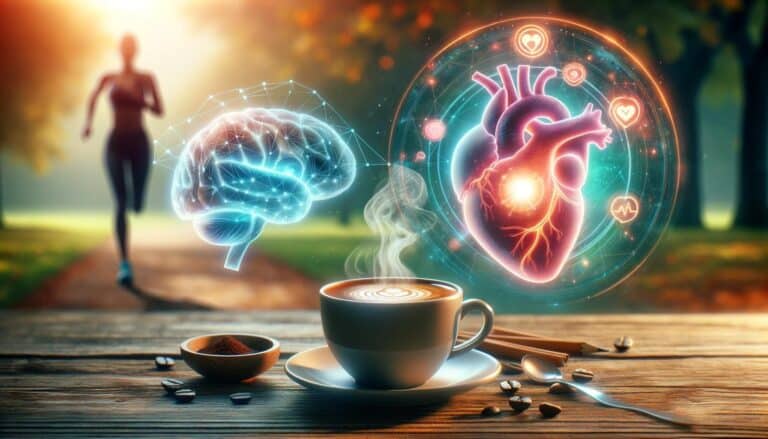Are you wondering about the differences between a latte and a flat white? You’re not alone. These two popular coffee drinks often stir up debate among coffee lovers. This article aims to clear up any confusion by explaining the key differences between lattes and flat whites.
We’ll explore each drink’s origins, how they’re made, and what sets them apart in terms of taste, texture, and strength. By the end of this guide, you should have a clear understanding of these beverages and feel confident in choosing the one that best matches your coffee preferences.
Latte vs. Flat White: Quick Answer
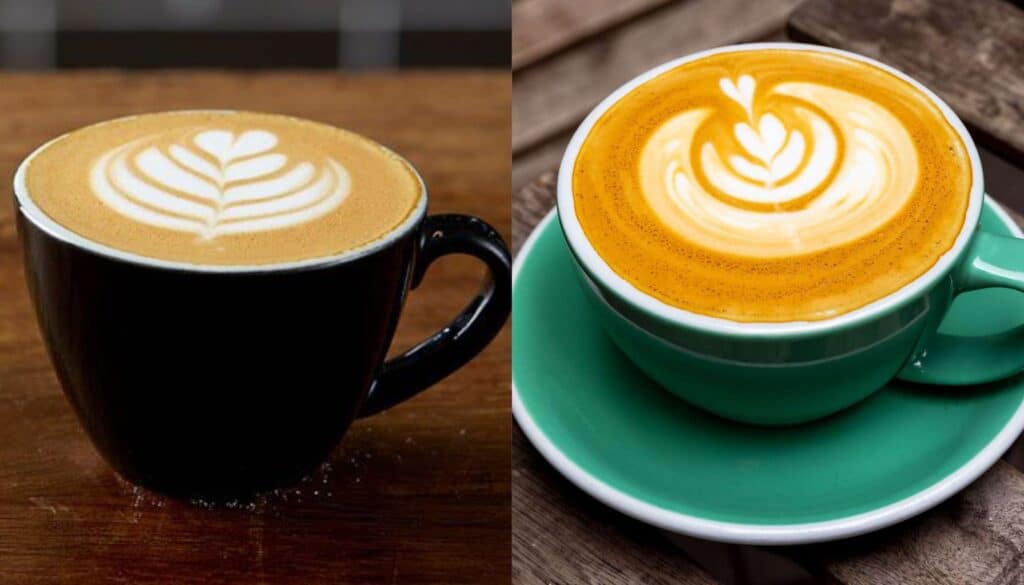
A latte and a flat white are both popular espresso-based drinks, but they differ primarily in their milk content and texture.
- Latte: This drink typically has a higher ratio of steamed milk to espresso, usually around 3 parts milk to 1 part espresso. It has a light layer of microfoam on top. Lattes are creamier and milkier, which makes them milder in flavor.
- Flat White: Originating from Australia and New Zealand, a flat white contains a higher concentration of espresso and less milk than a latte. It is characterized by a thin layer of velvety microfoam, making the coffee flavor more pronounced compared to a latte.
Both drinks are often served in similar cup sizes, but the flat white will have a stronger coffee flavor due to the higher espresso to milk ratio.
Understanding Espresso-Based Drinks

Espresso-based drinks are a staple in coffee culture, crafted from a concentrated coffee made by forcing hot water through finely ground coffee beans. This method produces a thick, rich coffee known as espresso, which serves as the foundation for many beverages in cafes worldwide.
The ratio of coffee to milk in these drinks is crucial because it significantly influences their flavor and texture. For instance, more milk can soften the intense taste of espresso, giving a creamy texture and a milder flavor. Conversely, a drink with less milk will highlight the robust, deep flavors of the espresso, offering a stronger coffee experience. Understanding this balance is key to appreciating the subtleties of espresso-based beverages.
The Latte: Origins and Characteristics

History of the Latte
The latte, known for its smooth and creamy texture, has roots that trace back to Europe but has found a particular resonance in American coffee culture. The term “latte” in Italian simply means “milk,” which points to the drink’s essential components: espresso and steamed milk. In coffee culture, lattes have become synonymous with a comforting, mild coffee experience that appeals broadly, integrating seamlessly into the morning routines of millions.
As lattes spread across the globe, particularly in America, they adapted to local tastes. In the United States, lattes evolved to include a variety of flavors, such as vanilla, caramel, and pumpkin spice, becoming larger and sweeter than their European counterparts.
Making a Latte
Ingredients and Typical Proportions
A classic latte combines one part espresso to three parts steamed milk, topped with a small layer of foam.
Step-by-Step Process
- Brew the Espresso: Start by brewing a shot of espresso using a quality coffee machine.
- Steam the Milk: Heat milk to create a smooth and silky texture without creating too much foam.
- Combine and Pour: Pour the espresso into a cup, followed by the steamed milk. Aim to achieve a good blend of espresso and milk.
- Top with Foam: Gently add a thin layer of milk foam on top to finish the drink.
Taste Profile
Lattes have a creamy texture that softens the espresso’s bitterness, making it a favored choice for those who enjoy a milder coffee flavor. This drink is ideal for those who appreciate the taste of coffee but prefer a less intense experience.
Understanding these elements of the latte helps to appreciate its place in coffee culture and why it may be the preferred morning beverage for many around the world.
Types of Lattes
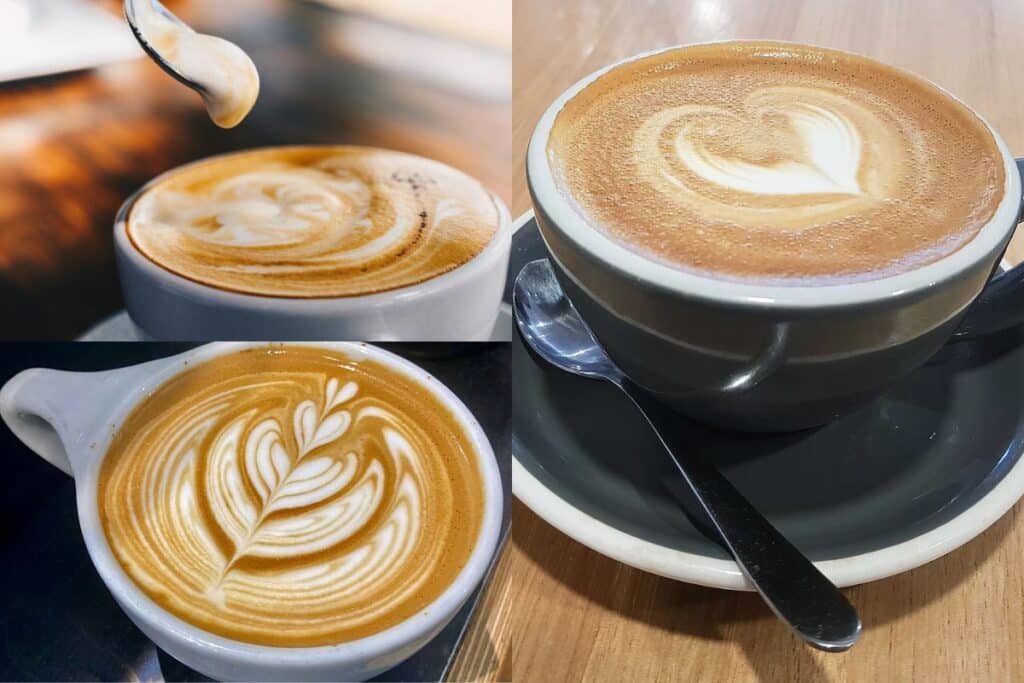
Lattes, known for their versatility and adaptability, come in an array of flavors and styles, catering to a wide range of tastes. Here’s a look at some popular types of lattes that you might encounter in cafes or consider trying at home:
Classic Latte
- Description: The classic latte combines espresso with steamed milk and a light topping of foam. It’s the base model for all lattes.
- Best For: Coffee enthusiasts who appreciate the pure, creamy taste of a traditional latte without additional flavors.
Flavored Lattes
- Description: These lattes include various syrups or powders to add flavor. Common flavors include vanilla, caramel, hazelnut, and cinnamon.
- Best For: Those who enjoy a sweet touch to their coffee or like to experiment with different tastes.
Iced Latte
- Description: Prepared with espresso and cold milk, then poured over ice, the iced latte is a refreshing alternative to hot coffee drinks.
- Best For: Coffee lovers looking for a cool, refreshing drink, especially during warmer weather.
Mocha Latte (Caffè Mocha)
- Description: A blend of chocolate, espresso, and steamed milk, topped with whipped cream or marshmallows for extra indulgence.
- Best For: Anyone with a sweet tooth or those who enjoy the rich combination of coffee and chocolate.
Matcha Latte
- Description: Instead of espresso, this latte uses matcha green tea powder mixed with steamed milk, offering an earthy flavor and a boost of antioxidants. Matcha Latte Recipe.
- Best For: Health-conscious individuals or tea lovers who want the latte experience without the coffee.
Chai Latte
- Description: Made with spiced chai tea concentrate or powder instead of espresso, combined with steamed milk. Chai Latte Recipe.
- Best For: Those who prefer tea over coffee but enjoy the creamy texture of a latte.
Each type of latte offers a unique flavor and experience, making lattes a versatile choice for many coffee drinkers. Whether you prefer your latte hot or cold, flavored or plain, there’s a latte style out there to satisfy your coffee cravings.
The Flat White: A Distinct Identity
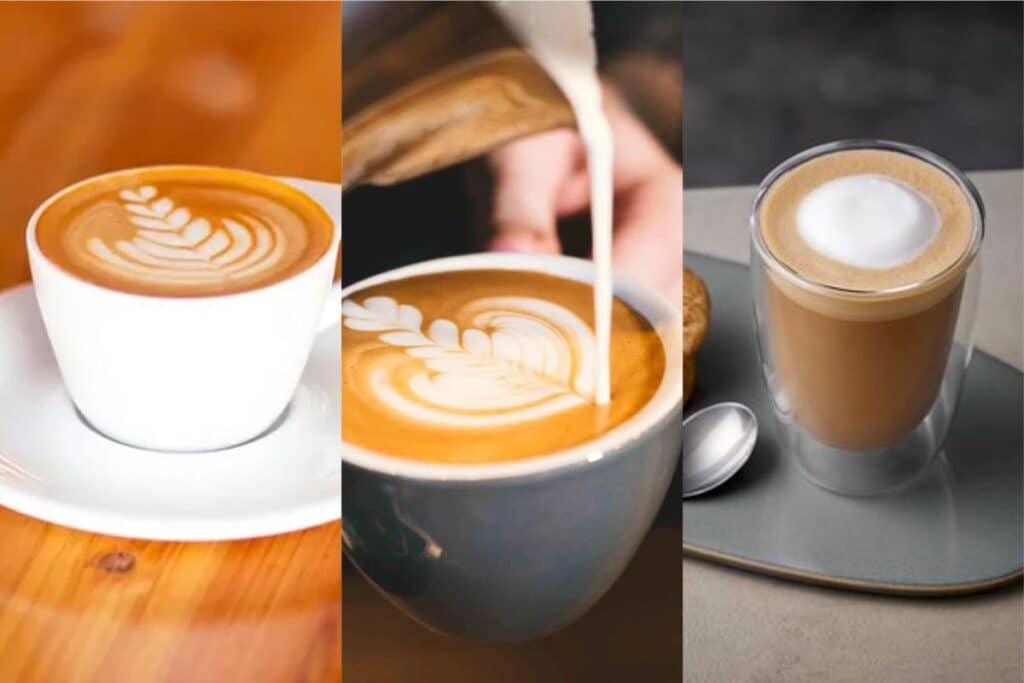
History of the Flat White
The origins of the flat white are a topic of friendly contention between Australia and New Zealand, each claiming to have birthed this beloved coffee drink. In both countries, the flat white holds a special place in coffee culture, symbolizing a preference for strong, espresso-forward beverages that reflect a sophisticated coffee palate.
Making a Flat White
Ingredients and Differences from the Latte
A flat white is typically made with a double shot of espresso and a smaller proportion of steamed milk compared to a latte. The key difference lies in the milk’s texture and the ratio of coffee to milk.
Detailed Brewing Technique
- Brew the Espresso: Start with a double shot of rich, dark espresso for a robust base.
- Steam the Milk: Carefully steam the milk to achieve a velvety consistency with fine microfoam, less airy and more integrated than latte foam.
- Pour and Integrate: Pour the steamed milk into the espresso from a low height to blend smoothly, enhancing the coffee’s body without overwhelming it with foam.
Flavor Profile and Ideal Consumer
The flat white offers a stronger espresso flavor balanced by the creamy texture of the milk, appealing to those who enjoy a pronounced coffee taste but still appreciate some milkiness. It’s perfect for coffee lovers who seek a potent but smooth experience, often preferred by those who find a latte too mild or a straight espresso too intense.
The flat white has carved out a niche in the coffee scenes of Australia and New Zealand, celebrated for its strong yet smooth flavor profile that captures the essence of both regions’ coffee cultures.
Types of Flat White
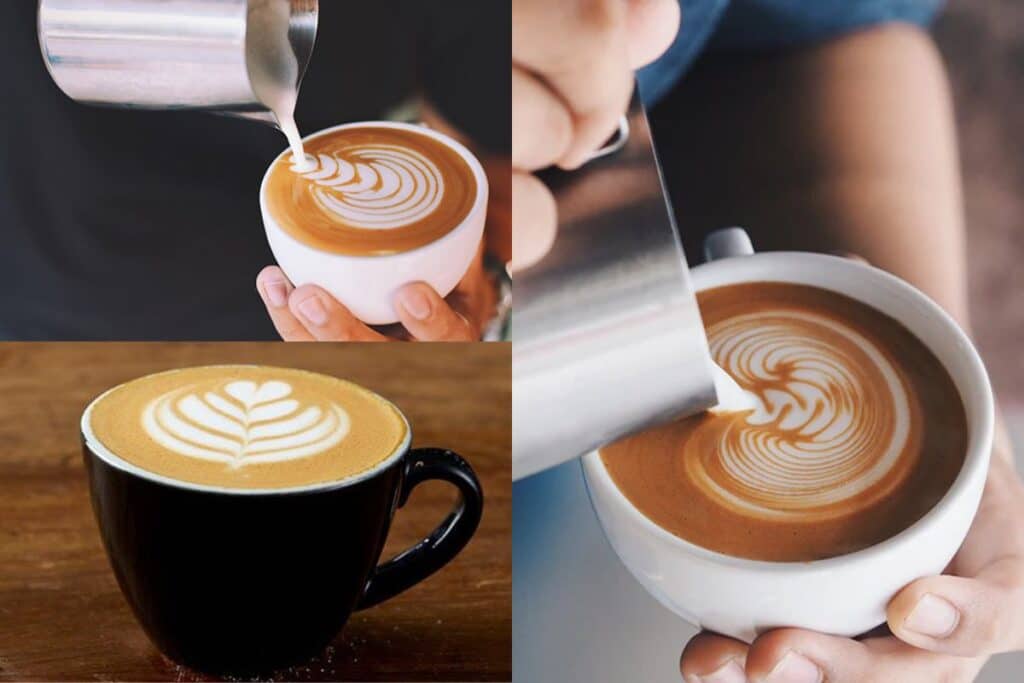
Flat whites, known for their strong espresso flavor and velvety milk texture, are generally less varied than lattes but can still offer some regional and stylistic differences. Here’s a look at some interpretations of the flat white that you might find interesting:
Classic Flat White
- Description: This is the standard flat white, made with a double shot of espresso and a small amount of steamed milk with fine microfoam. It is typically served in a smaller, 5-6 ounce cup.
- Best For: Coffee purists who appreciate a strong espresso flavor balanced with just a hint of creamy milk.
Single Origin Flat White
- Description: Made using single-origin coffee beans, which can vary in flavor according to their region, providing a unique tasting experience.
- Best For: Coffee aficionados looking to explore different coffee bean profiles and how they influence the taste of their flat white.
Organic Flat White
- Description: This version uses organic milk and coffee, appealing to those who prefer ingredients that are free from pesticides and other chemicals.
- Best For: Environmentally conscious consumers who prioritize organic products for health and ecological reasons.
Iced Flat White
- Description: An adaptation for warmer weather, this flat white is prepared with chilled milk and served over ice, maintaining the strong coffee flavor typical of a flat white.
- Best For: Those who love the rich flavor of a flat white but need a cooler beverage option. Iced Flat White Recipe!
Almond Milk Flat White
- Description: A dairy-free variant of the traditional flat white, using almond milk instead of regular cow’s milk, which offers a slightly nutty flavor and lighter texture.
- Best For: Lactose intolerant individuals or those preferring plant-based milk options. Almond Milk Flat White Recipe!
While the flat white tends to stick closer to its traditional roots compared to the highly adaptable latte, these variations allow coffee lovers to enjoy this strong, espresso-forward drink in ways that suit their taste preferences and dietary needs. Each type maintains the core characteristics of a flat white, focusing on the quality of the espresso and the silky texture of the milk.
Comparative Analysis: Latte vs. Flat White

Coffee to Milk Ratio
The fundamental difference between a latte and a flat white lies in their coffee to milk ratios, which significantly impacts the beverage’s overall character. In a latte, the ratio typically spans from one part espresso to three parts steamed milk, resulting in a creamier and more subdued espresso flavor. This makes the latte a favorite among those who prefer their coffee milder.
Conversely, a flat white uses a higher proportion of coffee, generally two parts espresso to one part milk. This ratio highlights the espresso’s robust flavors, making it ideal for those who appreciate a stronger coffee taste without the harshness of black coffee.
Milk Texture and Presentation
The texture of the milk in these drinks also plays a critical role in defining their identities. Lattes feature a significant amount of microfoam, which is silky and thick, contributing to a smooth and velvety mouthfeel. This texture complements the mild flavor profile of the latte, making it a soothing, easy-to-drink choice.
Flat whites, however, use steamed milk that has a creamier, more velvety texture with very little foam. This method preserves the strong coffee flavor and offers a denser, richer experience. The delicate balance of fine foam in a flat white ensures that the espresso remains the dominant flavor.
Serving Size and Customization Options
Lattes are generally served in larger sizes, typically ranging from 8 to 16 ounces, which suits those looking to enjoy their drink over a longer period. The larger size also accommodates various flavor additives, such as syrups or spices, making lattes highly customizable according to individual taste preferences.
Flat whites are usually served in smaller sizes, about 5 to 6 ounces, which helps maintain the coffee’s temperature and flavor concentration. This size is less conducive to flavor additions but perfect for those who prefer a quick, intense coffee experience.
Customization options in cafes reflect these differences. Lattes often come with a variety of syrup flavors and milk alternatives, allowing for a personalized beverage. Flat whites, being more traditional, are typically offered with fewer customization options, focusing on the quality and preparation of the espresso and milk.
This comparative analysis shows that while both lattes and flat whites are espresso-based, their preparation, texture, and serving sizes cater to different tastes and coffee drinking experiences.
Conclusion: Latte vs. Flat White

In our exploration of lattes and flat whites, we’ve uncovered distinct differences that cater to varied palates within the coffee-loving community. Lattes offer a creamier, milder coffee experience with plenty of room for customization through flavors and milks, making them a beloved choice for those who enjoy a less intense coffee flavor. Flat whites, characterized by their strong espresso presence and minimalistic milk addition, appeal to those who prefer a more robust coffee flavor that highlights the espresso itself.
For coffee enthusiasts, understanding these differences is crucial not just for choosing a preferred drink, but also for appreciating the craftsmanship behind each beverage. Whether you lean towards the velvety texture of a latte or the concentrated boldness of a flat white, each drink offers a unique window into the art of coffee making.
We encourage you to try both types of drinks to fully appreciate their unique qualities. Experimenting with both can enhance your understanding of coffee and help you discover your personal preference, which in turn can enrich your overall coffee experience. So next time you visit your favorite cafe, consider alternating your order between a latte and a flat white to truly savor what each has to offer.
Frequently Asked Questions: Latte vs. Flat White

1. What is the main difference between a latte and a flat white?
- Answer: The primary difference lies in the ratio of espresso to milk and the texture of the milk used. Lattes have a higher proportion of steamed milk and are topped with a thicker layer of foam, making them creamier and milder in flavor. Flat whites feature a higher concentration of espresso and use velvety steamed milk with a very thin layer of microfoam, highlighting the espresso’s robust flavor.
2. Can I make a flat white or latte at home without an espresso machine?
- Answer: Yes, you can approximate these drinks at home even without an espresso machine. For a latte or flat white, you can use a strong brew from a regular coffee maker or a stovetop espresso maker like a Moka pot. For the milk, you can heat and whisk it manually to create foam, though it may not be as fine as what is achievable with a steamer.
3. Are there non-dairy options suitable for lattes and flat whites?
- Answer: Absolutely! Both drinks can be made with any non-dairy milk alternative, including almond milk, oat milk, soy milk, and coconut milk. Each milk alternative will add its unique flavor and texture to the drink.
4. How do baristas achieve the perfect microfoam for a flat white?
- Answer: Achieving perfect microfoam requires skill and practice. Baristas steam the milk to an ideal temperature of around 150°F, creating tiny bubbles that result in a silky and velvety texture. The key is to introduce just enough air to create small, uniform bubbles and then to integrate the air throughout the milk for a smooth, glossy finish.
5. What are the best coffee beans to use for a latte or flat white?
- Answer: The choice of coffee beans can depend on personal taste, but generally, a medium to dark roast works well for both lattes and flat whites as they provide a strong flavor that can balance the milk’s sweetness. Single-origin beans are popular for their distinctive flavor profiles, which can enhance the overall experience of the drink.
6. Is there a specific type of cup recommended for serving a flat white or latte?
- Answer: Traditionally, flat whites are served in a smaller, 5 to 6-ounce tulip-shaped cup to enhance the coffee flavor and maintain the drink’s temperature. Lattes are usually served in larger, 8 to 16-ounce cups that accommodate the greater volume of milk. The choice of cup can affect the thermal dynamics and the drinking experience, highlighting the beverage’s aroma and flavor.

